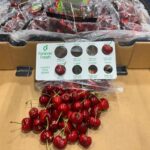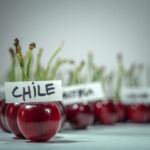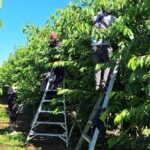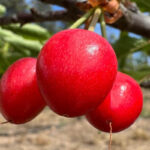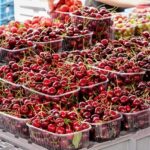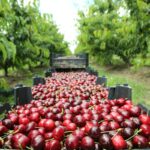Chile: Alcaino urges Chilean cherry exporters to build U.S. retail programs

With Chile's cherry production volume set to double in four to five years, a fruit industry expert said finding alternative markets would be a "healthy proposal".
Speaking at the inaugural Global Cherry Summit held in San Francisco de Mostazal this week, Decofrut president Manuel Alcaino's presentation showed how the industry was essentially putting all its cherries in one basket - China.
Around 90% of Chile's 187,142 metric tons (MT) of cherry exports went to Asia in 2017-18, and 96% of that volume went to the Chinese market.
In contrast, North America only received 8,122MT, which may represent an untapped deal for an industry on the ascent.
"The Americans consume a volume from the United States that is superior to what we exported to the world this year. That is about 200,000MT," Alcaino said.
"Let’s suppose that we are able to negotiate programs for four or five million cases to the United States," he said.
Proposing a hypothetical exercise where the industry were able to achieve retail prices of US$12 per kilo (2.2 pounds), he said this would equate to prices of around US$30 FOB (freight on board) per case which could generate a reasonable return and take some pressure of volumes in China.
"Thinking about the American market, taking volumes and investing in the future, to me there's a lot of sense in it," he said.
Alcaino mentioned two of the best periods for sales in the U.S. market were in the lead up to Thanksgiving and Christmas, so exporters should aim to sell at those times.
"We can see that afterwards in reality the prices of Chilean cherries decline in a way that isn’t significant but notable. And it’s very much on the limits of what we’ve said," he mentioned, referring to what would be considered ideal prices.
But this may simply come down to the Chilean approach in the U.S. market to date.
"Please let’s not continue with the idea that this [good] fruit goes to China, and the bad goes to the United States," he said.
"It requires an effort that hasn’t been done. What does that work involve? It consists of preparing programs. You have to sit down with the retail chains in the United States and explain to them what will happen."
He said these programs would need to consist of pre-determined sizes which would actually be less demanding than the Chinese market.
On the other hand exporters could not expect a large percentage of their fruit to meet 'US #1' quality specifications but rather one rung below, still focusing on bringing the right varieties for the U.S. market, fruit firmness and crunchiness, and having a low incidence of pitting.
He added the sector also needed to find an alternative to the current 500g bag format it was currently using to ship cherries to the U.S. market.
A U.S. cherry sector perspective
Northwest Cherries president B.J. Thurlby agreed there was a possibility Chile could put more focus on the U.S. market, emphasizing only one in three of his compatriots currently consumed cherries but that could potentially increase to two thirds.
Thurlby added there was also a class of 'super consumers' who only represented 13% of cherry consumers but purchased 35% of the fruit. It is for this sub-set that quality must be guaranteed in order to keep the category strong.
"What we’re seeing is that the growers are being pushed towards us and we’re starting to see more and more organic cherries show up in the United States," he said.
He pointed to a lot of "correlation" between the Pacific Northwest and Chile in terms of both cherries and the landscape more broadly.
"In the Northwest we picked the largest crop we have ever picked this last year in 2017. And sure enough, here in Chile, you folks, you growers have picked the largest crop you’ve ever picked," he said.
Production-wise, he said growers in his region had increased acreage by 46% in the last decade, yet the country's overall increase has been just 10%.
"There have been other areas in the United States like New York, Pennsylvania, Michigan; Michigan used to grow a lot of sweet cherries, and they’ve been pulling them out, and so we’ve seen actual acreage increases continue to go up, but not as fast as we’ve seen in the Northwest," Thurlby said.
"But here’s kind of the kicker, so over the last 10 years, sweet cherry production in volume has actually increased by 28% in the United States, and that’s because, I believe quite simply, we’ve just changed our managing of our orchards, and we’re managing much more high density acreage.
He said acreage was currently heavily geared toward the variety Bing but growers were pulling it out in favor of others, such as Skeena, Santina or Regina.
In terms of this U.S. season, he said California was now just starting harvests with its earliest varieties.
"They're already talking, and their crop’s going to be down between four and five million - this crop is already short; it just didn’t set well and we had some frost, so they’re talking four million boxes," he said.
"We’ve had pretty cold weather [in the Northwest]. We had some nice warm weather in February and then it just dropped, so we’re going to start late again this year, I'm thinking around the 6th of June.
"Only half of our growing districts have pollinated, but we’ve had this windy, cold, rainy weather through pollination and I’m thinking if we had 22 or 23 million boxes this year in the Northwest then that should be a pretty good crop for us based on the pollination and weather."
He said in the absence of any big rainfall events, the total West Coast crop could be between 27-28 million boxes in 2018.
Headline photo: www.shutterstock.com


















